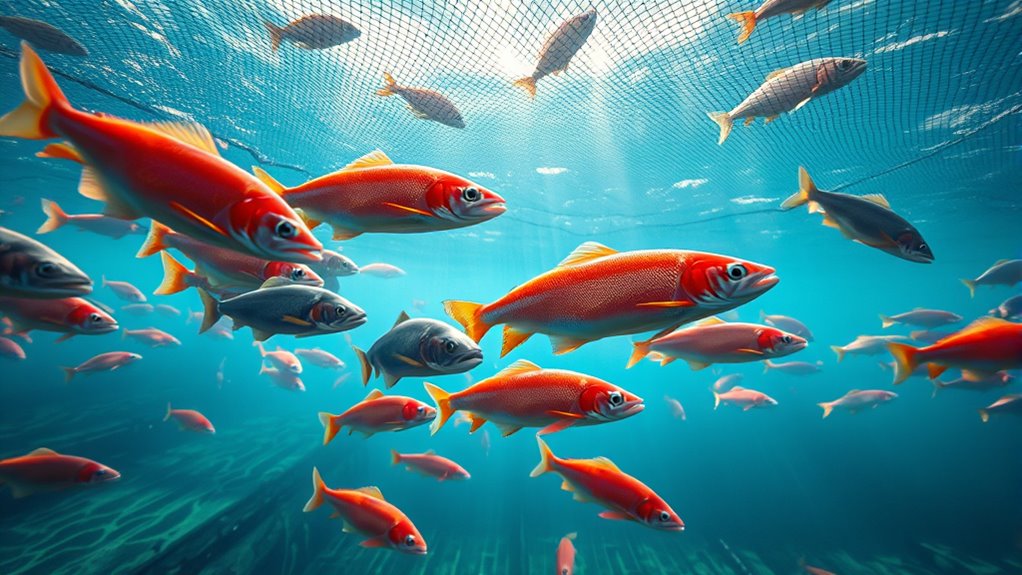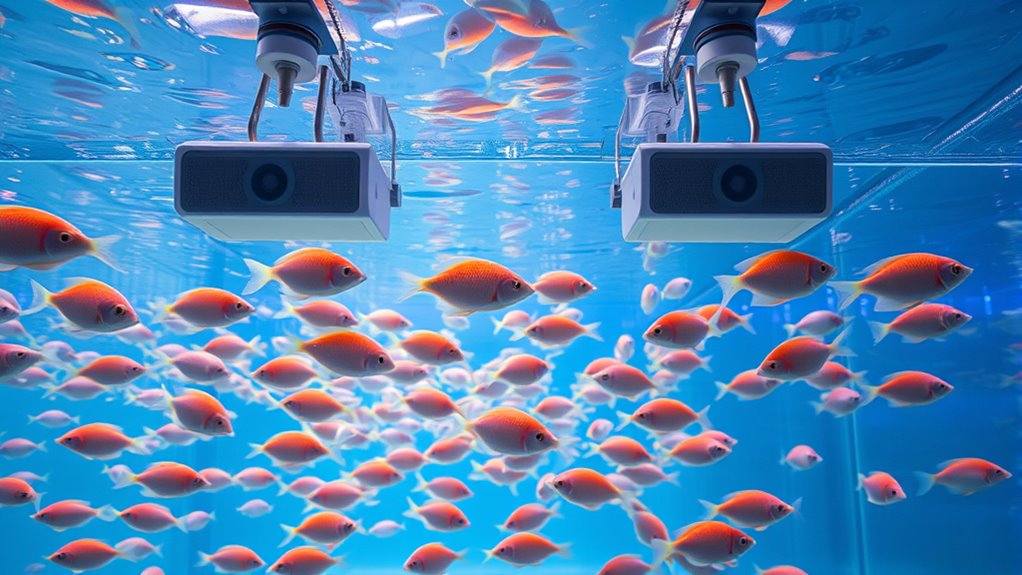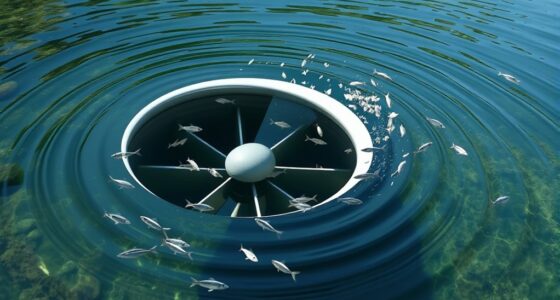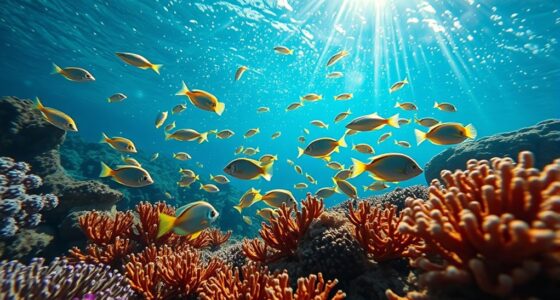Using Mozart music in fish farms can boost growth by creating a calming environment that reduces stress among fish. The soothing sounds encourage better feeding behavior and healthier development. This method is simple to implement and eco-friendly, requiring only waterproof speakers and proper placement. If you keep exploring, you’ll discover how music therapy may become a key tool for sustainable aquaculture and improving farm productivity.
Key Takeaways
- Playing Mozart music in fish farms enhances growth rates by creating a calming environment.
- Music therapy reduces fish stress, improving feed efficiency and overall health.
- Implementation involves waterproof speakers and controlled playback during key growth phases.
- Using music minimizes reliance on chemicals, supporting sustainable, eco-friendly aquaculture.
- The beneficial effects are linked to vibrations and harmonious sounds positively influencing fish biology.

Researchers have discovered that playing Mozart music can considerably enhance the growth rate of fish in farms. This finding opens up exciting possibilities for aquaculture, especially as farmers seek sustainable ways to increase productivity while minimizing environmental impact. The concept of music therapy isn’t new in human medicine, but applying it to fish farming is innovative. By introducing carefully selected melodies like Mozart’s, you can create a calmer, more harmonious environment for your fish, which translates into healthier, faster-growing stock. The soothing rhythms help reduce stress levels among the fish, leading to more efficient feed conversion and improved overall health. This approach not only benefits your yields but also aligns with environmentally friendly practices by reducing the need for chemical or pharmaceutical interventions.
Implementing music therapy in fish farms is straightforward, but it requires understanding the specific effects of music on aquatic life. When you play Mozart, the gentle vibrations and harmonious sounds influence the fish’s nervous systems, promoting a state of relaxation. This calm state encourages better feeding behavior and reduces aggressive interactions, which can otherwise hinder growth. As a result, your fish spend less energy on stress responses and more on growth, making your farm more efficient. Furthermore, the environmental impact of integrating music therapy is minimal. Unlike chemical treatments, which can pollute water sources and harm local ecosystems, music-based interventions are clean and sustainable. You’re effectively enhancing your farm’s productivity without risking the health of surrounding habitats or requiring extensive modifications to existing infrastructure.
Additionally, understanding the genetic variation among fish can help optimize the use of music therapy for different species and breeds. From a practical standpoint, you’ll want to contemplate the placement of speakers and the duration of music exposure. Studies suggest that consistent, moderate-volume playback during key growth phases yields the best results. You don’t need complex equipment—simple waterproof speakers placed strategically around the tanks or ponds work well. The key is maintaining a calm auditory environment that mimics natural conditions, reducing stress and encouraging growth. By doing so, you’re not just improving your farm’s output—you’re also contributing to a more environmentally conscious approach to aquaculture. This method demonstrates that technological innovation and sustainability can go hand-in-hand, providing a model for future fish farming practices.
Frequently Asked Questions
How Does Music Influence Fish Growth at a Biological Level?
You might wonder how music influences fish growth biologically. When exposed to calming sounds like Mozart, stress levels decrease, leading to stress reduction. This lowered stress can enhance gene expression related to growth and immune function. As a result, fish allocate more energy to development rather than stress responses, promoting healthier, faster growth. So, music acts as a natural growth booster by positively affecting their biological processes.
Are There Other Animals Affected Positively by Similar Sound Therapies?
Imagine you’re in a sci-fi movie where sound therapy transforms aquatic animals. You might find that other animals, like whales or dolphins, also respond positively to specific sound frequencies. These creatures, like fish, seem to benefit from sound therapy, which can reduce stress and promote growth. Scientific studies suggest that various aquatic animals are influenced by sound, making it a promising tool for enhancing their well-being across different species.
What Specific Mozart Pieces Are Most Effective for Fish Growth?
You might wonder which Mozart pieces work best for fish growth. In aquarium acoustics, musical stimulation plays a vital role. Typically, lively, upbeat compositions like Mozart’s “Sonata for Two Pianos in D Major” or “Eine kleine Nachtmusik” are most effective. These pieces create an environment that promotes healthy development, so you should experiment with different selections to see which resonates best with your fish and enhances their growth.
Is This Practice Cost-Effective for Commercial Fish Farms?
You might wonder if playing Mozart is cost-effective for your fish farm. A thorough cost analysis shows that investing in sound systems and music licensing can be offset by faster fish growth and improved health, making the practice economically feasible. While initial costs exist, the potential for increased yields and reduced medication expenses can boost your farm’s profitability, making this innovative approach a worthwhile consideration for sustainable operations.
Could Other Music Genres Outperform Mozart in Promoting Growth?
While exploring the possibilities of sound frequency through music therapy, you might wonder if other genres could surpass Mozart in promoting growth. You probably realize that different sound patterns can influence aquatic environments uniquely. It’s worth experimenting with various music styles, as some may offer unexpected benefits. Ultimately, broadening your approach could open even more effective methods for boosting fish growth, making your farm more productive and resilient.
Conclusion
So, next time you see a fish farm, imagine tiny Mozart maestros conducting a symphony of bubbles and scales, turning your seafood into super-fish! With the power of classical music, these fish are practically flying off the shelves, growing faster than you can say “ocean’s biggest catch.” It’s like turning a quiet pond into a roaring concert hall where the fish perform the ultimate growth symphony—your dinner just got a whole lot more legendary!










